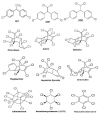Chemical Contamination Pathways and the Food Safety Implications along the Various Stages of Food Production: A Review
- PMID: 34071295
- PMCID: PMC8199310
- DOI: 10.3390/ijerph18115795
Chemical Contamination Pathways and the Food Safety Implications along the Various Stages of Food Production: A Review
Abstract
Historically, chemicals exceeding maximum allowable exposure levels have been disastrous to underdeveloped countries. The global food industry is primarily affected by toxic chemical substances because of natural and anthropogenic factors. Food safety is therefore threatened due to contamination by chemicals throughout the various stages of food production. Persistent Organic Pollutants (POPs) in the form of pesticides and other chemical substances such as Polychlorinated Biphenyls (PCBs) have a widely documented negative impact due to their long-lasting effect on the environment. This present review focuses on the chemical contamination pathways along the various stages of food production until the food reaches the consumer. The contamination of food can stem from various sources such as the agricultural sector and pollution from industrialized regions through the air, water, and soil. Therefore, it is imperative to control the application of chemicals during food packaging, the application of pesticides, and antibiotics in the food industry to prevent undesired residues on foodstuffs. Ultimately, the protection of consumers from food-related chemical toxicity depends on stringent efforts from regulatory authorities both in developed and underdeveloped nations.
Keywords: food safety; heavy metals; persistent organic pollutants; regulatory strategies.
Conflict of interest statement
The authors declare that there is no conflict of interest.
Figures







Similar articles
-
Sources, pathways, and relative risks of contaminants in surface water and groundwater: a perspective prepared for the Walkerton inquiry.J Toxicol Environ Health A. 2002 Jan 11;65(1):1-142. doi: 10.1080/152873902753338572. J Toxicol Environ Health A. 2002. PMID: 11809004 Review.
-
Assessment of pops contaminated sites and the need for stringent soil standards for food safety for the protection of human health.Environ Pollut. 2019 Jun;249:703-715. doi: 10.1016/j.envpol.2019.03.066. Epub 2019 Mar 20. Environ Pollut. 2019. PMID: 30933768
-
Persistent organic pollutants in fish: biomonitoring and cocktail effect with implications for food safety.Food Addit Contam Part A Chem Anal Control Expo Risk Assess. 2019 Apr;36(4):601-611. doi: 10.1080/19440049.2019.1579926. Epub 2019 Mar 12. Food Addit Contam Part A Chem Anal Control Expo Risk Assess. 2019. PMID: 30862267
-
Occurrence of environmental pollutants in foodstuffs: A review of organic vs. conventional food.Food Chem Toxicol. 2019 Mar;125:370-375. doi: 10.1016/j.fct.2019.01.021. Epub 2019 Jan 22. Food Chem Toxicol. 2019. PMID: 30682385 Review.
-
Dioxin- and POP-contaminated sites--contemporary and future relevance and challenges: overview on background, aims and scope of the series.Environ Sci Pollut Res Int. 2008 Jul;15(5):363-93. doi: 10.1007/s11356-008-0024-1. Epub 2008 Jul 3. Environ Sci Pollut Res Int. 2008. PMID: 18597132 Review.
Cited by
-
One-Pot Synthesis of TiO2-rGO Photocatalysts for the Degradation of Groundwater Pollutants.Materials (Basel). 2021 Oct 10;14(20):5938. doi: 10.3390/ma14205938. Materials (Basel). 2021. PMID: 34683530 Free PMC article.
-
Food contaminants and potential risk of diabetes development: A narrative review.World J Diabetes. 2023 Jun 15;14(6):705-723. doi: 10.4239/wjd.v14.i6.705. World J Diabetes. 2023. PMID: 37383596 Free PMC article. Review.
-
Inhibitory effect of natural extract mixtures on microbial growth and lipid oxidation of sausages during storage.J Anim Sci Technol. 2023 Jan;65(1):225-243. doi: 10.5187/jast.2022.e92. Epub 2023 Jan 31. J Anim Sci Technol. 2023. PMID: 37093932 Free PMC article.
-
Sources, effects and present perspectives of heavy metals contamination: Soil, plants and human food chain.Heliyon. 2024 Mar 26;10(7):e28357. doi: 10.1016/j.heliyon.2024.e28357. eCollection 2024 Apr 15. Heliyon. 2024. PMID: 38590838 Free PMC article. Review.
-
The Trade-Off Between Sanitizer Resistance and Virulence Genes: Genomic Insights into E. coli Adaptation.Antibiotics (Basel). 2025 Mar 11;14(3):291. doi: 10.3390/antibiotics14030291. Antibiotics (Basel). 2025. PMID: 40149102 Free PMC article.
References
-
- Ahmad S., Masood F., Khatoon K., Malik A. Risk Management of Chemical Hazards Arising During Food Manufacturing. In: Malik A., Erginkaya Z., Erten H., editors. Health and Safety Aspects of Food Processing Technologies. 1st ed. Springer International Publishing; Cham, Switzerland: 2019. pp. 403–418.
-
- Vipham J.L., Amenu K., Alonso S., Ndahetuye J.-B., Zereyesus Y., Nishimwe K., Bowers E., Maier D., Sah K., Havelaar A., et al. No food security without food safety: Lessons from livestock related research. Glob. Food Secur. 2020;26:100382. doi: 10.1016/j.gfs.2020.100382. - DOI
-
- Nerín C., Aznar M., Carrizo D. Food contamination during food process. Trends Food Sci. Technol. 2016;48:63–68. doi: 10.1016/j.tifs.2015.12.004. - DOI
Publication types
MeSH terms
Substances
LinkOut - more resources
Full Text Sources
Medical

